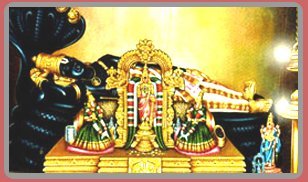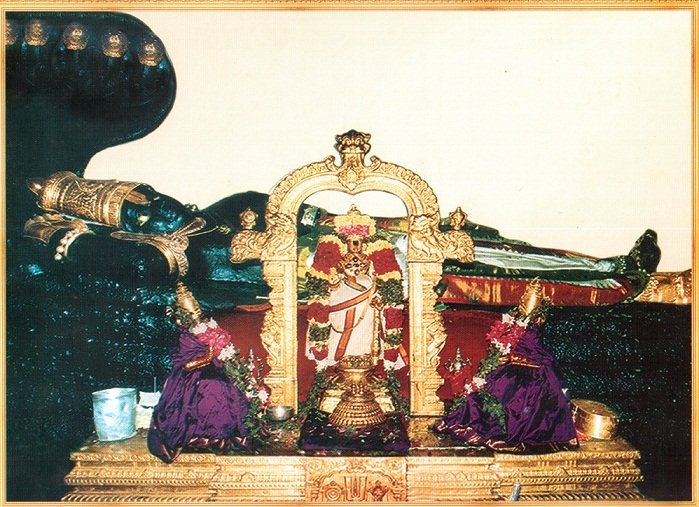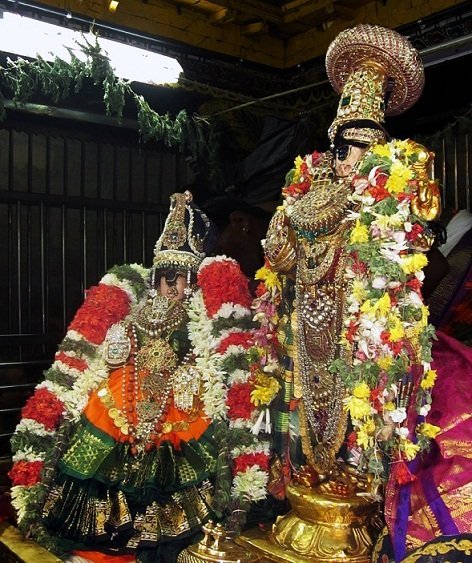srimathE rAmAnujAya nama:
srimadh varavaramunayE nama:
sri vAnAchala mahAmunayE nama:
In the previous article (https://granthams.koyil.org/2012/10/archavathara-anubhavam-andal-anubhavam/) we observed ANdAL’s archAvathAra anubhavam.
Let us now see thoNdaradippodi AzhwAr’s archAvathAra anubhavam.

mAmunigaL glorifies thoNdaradippodi AzhwAr’s greatness in his upadhEsa rathina mAlai 11th pAsuram. Let us enjoy that to start with.
manniyachIr mArgazhiyil kEttai inRu mANilaththIr (மன்னியசீர் மார்கழியில் கேட்டை இன்று மாநிலத்தீர்)
ennithanukku ERRam enil uraikkEn (என்னிதனுக்கு ஏற்றம் எனில் உரைக்கேன்)
thunnupugazh mAmaRaiyOn thonNdaradippodiyAzhwAr piRappAl (துன்னுபுகழ் மாமறையோன் தொண்டரடிப்பொடியாழ்வார் பிறப்பால்)
NAnmaRaiyOr konNdAdum NAL (நான்மறையோர் கொண்டாடும் நாள்)
Simple translation:
Oh the dwellers of this great world! Let me tell you why this mArgazhi kEttai day is a glorious day. It is because, on this day, thonNdaradippodi AzhwAr who is a braAhmaNoththamar (exalted brAhmaNa) and whose greatness is well established and who is celebrated by the ones who understood the essence of the four vEdhas.
In his vyAkyAnam, piLLai lOkam jIyar shows some wonderful points.
- He first identifies that AzhwAr is born in mArgazhi kEttai which has constant bhagavath bhAgavatha sambandham. kaNNan emperumAn identifies that he is “mArgasIrsham among the months” in bhagavath gIthai. ANdAL also glorifies the mArgazhi month in her first pAsuram itself. AzhwAr himself compiles thiruppaLLiyeLuchi which is sung along with thiruppAvai during the mArgazhi month.
- He identifies that the essence of vEdhas is bhAgavatha sEshathvam. This AzhwAr gets the name “thonNdaradippodi” which means he is the dust of the lotus feet of bhAgavathas out of his extreme attachment to bhAgavathas. This is also explained by thirumangai AzhwAr in thirukkaNNapuram pAsuram that after learning the meanings of thirumanthram he understands that now he is the servant of bhAgavathas.
- He also identifies that one who understands vEdhas will engage in guNAnubhava kainkaryam. AzhwAr glorifies emperumAn’s guNams in thirumAlai and he himself engaged in pushpa kainkaryam for periya perumAL. It is explained in other places that pushpa kainkaryam is the most apt kainkaryam for a srivaishnava (when done in the same bhAvam as done by periyAzhwAr, ANdAL, thonNdaradippodi AzhwAr, ananthAzhwAn, etc).
- Also, AzhwAr shows in thirumAlai that one should do constant naichyAnusandhAnam (humility – considering oneself very insignificant) and glorifying emperumAn.
NAnmaRaiyOr is very important here – one who understands vEdhas means they will accept the supremacy of sriman nArAyaNan. This is identified by ALavandhAr in his sthOthra rathnam 11th slOkam also. There he says “sriman nArAyNan has natural and unlimited abilities to control all the dhEvathas, and the other dhEvathas do not even have a tiny little bit of the abilities of emperumAn. Which vaidhiha will not accept the greatness and supremacy of emperumAn?”. Here “vaidhiha ka:” is the key phrase. This also means one who does not accept the greatness of sriman nArAyaNan is not even considered as vaidhiha (vaidhiha means one accepts and follows vEdhas).
AzhwAr singled out thiruvaranganAthan and fully served him and glorified him. He did not sing any other archAvathAra emperumAn. periyavAchAn piLLai shows that thonNdaradippodi AzhwAr and thiruppANAzhwAr are in the same category where they both were mainly focussed on thiruvaranganAthan.

In srivachana bhUshaNa dhivya sAsthram 40th sUthram, piLLai lOkAchAryar explains the glories of archAvathAra emperumAn.
ithuthAn sAsthranGgaLAl thiruththavonNnNaathE vishayANtharanGgaLilE manNdi vimukarAyp pOrum chEthanarkku vaimukyaththai maaRRi ruchiyai viLaikkak kadavathAy, ruchi piRaNthAl upAyamAy, upAya parikraham panNnNinaal bhOgyamumAyirukkum (இதுதான் ஸாஸ்த்ரங்களால் திருத்தவொண்ணாதே விஷயாந்தரங்களிலே மண்டி விமுகராய்ப் போரும் சேதனர்க்கு வைமுக்யத்தை மாற்றி ருசியை விளைக்கக் கடவதாய், ருசி பிறந்தால் உபாயமாய், உபாய பரிக்ரஹம் பண்ணினால் போக்யமுமாயிருக்கும்).
Simple translation:
When jIvAthma stays put in this samsAram even after learning the
svarUpam of oneself through sAsthram, the glories of emperumAn and the relationship
between the jIvAthmA and paramAthmA from the sAsthram, it is
archAvathAra emperumAn who removes the jIvathmA’s material attachments,
creates the ruchi (taste) for bhagavath vishayam, becomes the upAyam
(means) when ruchi manifests and finally, if the jIvAthmA accepts
emperumAn as the upAyam, emperumAn becomes the enjoyable goal as well.
Let us see how AzhwAr enjoyed all of the above in periya perumAL through his thirumAlai prabhandham.

In the vyAkyAna avathArikai, periyavAchAn piLLai shows that emperumAn out of his causeless mercy blesses AzhwAr (who was immersed in samsAram) and shows the glories of nAma sankIrtanam which shows his divine svarUpam (nature), rUpa (forms), guNa (qualities) and vibhUthi (both spiritual and material worlds). AzhwAr himself enjoys nAma sankIrthanam and emperumAn first and brings in joy for others (including emperumAn).
AzhwAr shows the favours done by periya perumAL to him in 15th to 24th pAsurams.
In the 15th and 16th pAsurams, AzhwAr says that periya perumAL out of his nirhEthuka krupai (causeless mercy) changes his attachment from material things to emperumAn himself.
meyyarkkE meyyanAgum vidhiyilA ennai pOla (மெய்யர்க்கே மெய்யனாகும் விதியிலா என்னை போல)
poyyarkkE poyyanAgum putkodiyudaiya kOmAn (பொய்யர்க்கே பொய்யனாகும் புட்கொடியுடைய கோமான்)
uyyapOm unNarvinArgatku oruvan enRu unNarNtha pinnai (உய்யபோம் உணர்வினார்கட்கு ஒருவன் என்று உணர்ந்த பின்னை)
aiyappAdu aRuththuth thOnRum azhaganUr aranGgamanRE (ஐயப்பாடு அறுத்துத் தோன்றும் அழகனூர் அரங்கமன்றே)
Simple Translation:
emperumAn, who has garudan in his flag, will bless the one like myself who does not hate emperumAn and will not bless the ones who likes everything other than emperrumAn.Once one understands that emperumAn exists, he further clears all the doubts. Such emperumAn who can win all the worlds with his beauty is residing in srirangam.
In the vyAkyAnam, periyavAchAn piLLai shows some of the most important principles of our sampradhAyam.
- Truthfulness (“mey“) here is explained as adhvEsham (absence of hatred towards emperumAn). emperumAn accepts some one purely based on them not having dhvEsham towards him. But even this does not become a sAdhanam (upAyam – means) to achieve emperumAn. Due to the eternal relationship between emperumAn and all jIvAthmAs, it is the nature of jIvAthmA to have ruchi towards emperumAn. So, this is only svarUpam of jIvAthmA but not upAyam to achieve emperumAn.
- Also “mey” is explained as sathyam which means true knowledge about emperumAn and “poy” means knowledge about anything other than emperumAn.
- AzhwAr’s thiruvuLLam is also revealed by periyavAchAn piLLai here. It is shown that he does not need any other pramANam than himself, where he did not have bhagavath anubhavam since time immemorial (anAdhi kAlam) and now when the dhvEsham is gone from his heart he is able to enjoy bhagavath anubhavam fully.
- Here doubts relate to the ishta prApthi (attaining the goal) and anishta nivruththi (removing the hurdles in doing so). Doubts related to both of them are cleared by emperumAn himself.
- It is also shown that the beauty of periya perumAL is such that, we can easily decide that he is the supreme.
chUdhanAy kaLvanAgi dhoorththarOdu ichaiNdha kAlam (சூதனாய் கள்வனாகி தூர்த்தரோடு இசைந்த காலம்)
mAdharAr kayaRkanNennum valaiyuL pattu azhuNdhuvEnai (மாதரார் கயற்கணென்னும் வலையுள் பட்டு அழுந்துவேனை)
pOdharE enRu cholli puNdhiyuL puguNdhu (போதரே என்று சொல்லி புந்தியுள் புகுந்து)
thanpAlAdharam perugavaiththa azhaganUr arangamanRE (தன்பாலாதரம் பெருகவைத்த அழகனூர் அரன்கமன்றே)
Simple Translation:
Before I was not accepting emperumAn, sAsthram and also considered myself as independent. Thus, I was engaged in very material aspirations. But periya perumAL invited me, entered into my heart and nourished the love towards him by showing his beautiful thirumEni in srirangam.
- Here for “kaLvar“, it is shown that the biggest theft is thinking that we are independent. Actually, the jIvAthmA is owned by emperumAn and is subservient to him. But if we stole that ownership, the punishment is very heavy because each jIvAthmA represents the “kouthuba jewel (mani)” in emperumAn’s chest. Stealing such valuable item deserves very big punishment. Also stealing emperumAn’s item deserves very big punishment. Nice examples are given for both scenarios. Punishment for stealing a piece of wood and a valuable jewel will differ. The same way stealing something from a common man and a high man in the society will have different punishment.
- periyavAchAn piLLai also explains the outcome of having attachment towards the opposite sex. Even great personalities have fallen in the trap of this attachment and had difficult times to come out of it.
- He also shows the difference between paramapadham and srirangam. For us who are in samsAram, if we want to enjoy bhagavath anubhavam, srirangam is so near and accessible unlike paramapadham.
In the 17th pAsuram onwards (for 8 pAsurams), AzhwAr says that periya perumAL not only manifested the ruchi in AzhwAr, he also gave himself as the most enjoyable goal.
Again, in the 34th pAsuram, AzhwAr starts doing naichyAnusandhAnam (humility). He says that he is laughing at himself for trying to cheat emperumAn by acting as an adiyAr, but emperumAn being the antharyAmi (in-dweller in everyone’s heart) knows everything AzhwAr thinks. Finally, AzhwAr thinks about leaving emperumAn since he feels that he does not fit the qualities of an adiyAr.
In the next 3 pAsurams, periya perumAL tries to console AzhwAr and makes him realize that he is indeed very attached to AzhwAr.
In the 35th pAsuram, periya perumAL shows him the thrivikrama charithram and makes AzhwAr realize that emperumAn touched everyone’s head as thrivikraman with his lotus feet, without discriminating between whether some one is learned or not, rich or poor, humans or animals or birds, etc.
In the 36th pAsuram, periya perumAL shows him the govardhana dharaNa charithram and makes AzhwAr realize that he became part of his adiyArs group, protected them during their difficulties, etc and establishes that he will remove all the hurdles that stop AzhwAr from reaching emperumAn.
In the 37th pAsuram, periya perumAL shows him that he has descended to srirangam to establish his parental relationship with all jIvAthmAs including AzhwAr. AzhwAr requests periya perumAL to acknowledge him as one who is looking to server him purely without any expectation in return and longs for the day when periya perumAL will accept him.
In the 38th pAsuram, AzhwAr performs sharaNAgathi to periya perumAL and shows that periya perumAL alone is the upAyam and AzhwAr has nothing to do in achieving him. This pAsuram is glorified greatly in our sampradhAyam. It is specifically explained by periyavAchAn piLLai in the vyAkyAnam that, just like the mahAbhAratham’s purpose is to deliver charama slOkam, the purpose of thirumAlai is to deliver this pAsuram.

Let us enjoy a little bit from this pAsuram.
mEmporuL pOga vittu meymmaiyai miga unNarNthu (மேம்பொருள் போக விட்டு மெய்ம்மையை மிக உணர்ந்து)
Amparichu aRiNthu konNdu aimpulan agaththadakki (ஆம்பரிசு அறிந்து கொண்டு ஐம்புலன் அகத்தடக்கி)
kAmbaRath thalai chiraiththu un kadaiththalai iruNthu (காம்பறத் தலை சிரைத்து உன் கடைத்தலை இருந்து)
vAzhum chOmbarai ugaththi pOlum chUzh punal aranGgaththAnE (வாழும் சோம்பரை உகத்தி போலும் சூழ் புனல் அரங்கத்தானே)
Simple translation:
Oh sriranganAthA who is residing in srirangam which is surrounded by cauvery! You are fully satisfied in seeing adiyArs who after giving up the attachments to materialistic aspirations even with its taste/memory, understand the true nature of the jIvAthmA, understand that bhagavath kainkaryam is the ultimate goal which fits the nature of the jIvAthmA, control the urge to enjoy the result of the kainkaryam (by letting emperumAn enjoy our kainkaryam fully), fully giving up any efforts from themselves and stay in srirangam happily.
Let us see some of the key points from the vyAkyAnam.
- It is shown that this pAsuram contains the full meaning of dhvaya mahA manthram. It is also shown that nammAzhwAr shows the first part of dhvayam in one pAsuram (thiruvAimozhi 6.10.10 – agalagillEn pAsuram) and ANdAL nAchiAr shows the second part of dhvayam in one pAsuram (thiruppAvai 29 – chiRRam chirukAlE pAsuram). But here thoNdaradippodi AzhwAr shows the whole meaning of dhvayam in a single pAsuram.
- It is also shown that, when emperumAn hears dhvayam (and its meaning) from his adiyArs, he becomes very pleased.
- periyavAchAn piLLai expertly explains that AzhwAr refutes different philosophies of bhAhyas (one who does not accept the vEdhas)/kudhrushtis (one who accepts vEdhas but interprets the meanings wrongly) like that of lOkAyatha, mImAmsaka and vaisEshika by establishing that AthmA is different from body, is full of jnAnam, is subservient to empermAn and his adiyArs.
- It is shown that our activity will match our identity. If we identify ourselves with our dhEham (body) our activity will be on a bodily platform (materialistic). But once we understand that we are dhAsan of emperumAn, then we will fully engage in kainkaryam only to him.
- “vAzhum chOmbar” (one who gloriously lives without any self efforts) is differentiated from “kedum chOmbar” (one who lazily survives without any true knowledge).
Rest of the pAsurams in thirumAlai are explained as glorifying the greatness of such adiyArs of emperumAn. AzhwAr explains in great detail how we should deal with such great srivaishnavas who fully accept and follow emperumAn as upAyam and upEyam. These pAsurams also relate to the fact that when one understands the true meaning of thirumanthram (and dhvayam) he/she will automatically surrender oneself to srivaishnavas and serve them in every opportunity.
Through his pAsurams and his life AzhwAr showed us how to fully surrender to archAvathAra emperumAn and how to serve him fully. Let us pray to his lotus feet so we also develop such attitude.
adiyen sarathy ramanuja dasan
https://granthams.koyil.org, also visit https://acharyas.koyil.org.
aazvar prefres thiruvarangam to parampadham. This archai attracts him so much that he is mesmerised to the extent of settling down here permanently.
இச சுவை தவிர யான போய் இந்திர லோகம் ஆளும் ஆசுவை பெறினும வேண்டேன் , அரங்க மா நகருளானே
yes swamy. thanks for bringing up this pAsuram.
thiruvadi (hanuman), thoNdaradippodi AzhwAr and thiruppANAzhwAr are so attracted to perumAL, periya perumAL and periya perumAL respectively that they even discarded paramapadha anubhavam. It is shown in the eedu arumpadham that, it is because of the similarity in their bhAvam, they are seen together in thiruvarangam periya kOil (behind rangavilAs mandapam).
adiyen sarathy ramanuja dasan